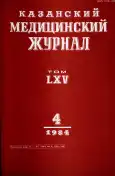Рентгенодиагностика постбульбарных супрапапиллярных стенозов двенадцатиперстной кишки
- Авторы: Сапранов Б.Н., Коковякин Г.П.
- Выпуск: Том 65, № 4 (1984)
- Страницы: 301-303
- Тип: Обмен клиническим опытом
- URL: https://journal-vniispk.ru/kazanmedj/article/view/89318
- DOI: https://doi.org/10.17816/kazmj89318
- ID: 89318
Цитировать
Полный текст
Аннотация
Обычное рентгенологическое исследование, широко применяемое для выявления патологии в гастродуоденальной зоне, является недостаточным для получения анатомического представления о двенадцатиперстной кишке. На наш взгляд, ее полноценное исследование можно проводить методом беззондовой дуоденографии, который в нашей модификации заключается в следующем. После обзорной рентгеноскопии грудной и брюшной полостей больной выпивает два-три глотка бариевой взвеси, и производится исследование слизистой пищевода и желудка методом серийной прицельной рентгенографии. Если бариевая взвесь поступает и в двенадцатиперстную кишку, выполняем серию снимков ее контрастированных отделов. Далее больной выпивает остальную порцию бариевой взвеси и принимает две таблетки аэрона под язык (прием аэрона внутрь нецелесообразен вследствие наличия в желудке бариевой взвеси, тем более что аэрон при приеме под язык, как показали наши наблюдения, действует практически так же, как при приеме внутрь). Осмотрев желудок при его тугом наполнении контрастным веществом, приступаем к исследованию двенадцатиперстной кишки. Для этого больного укладываем на правый бок на 15 мин, штатив переводим в трохопозицию и выполняем серию прицельных и обзорных снимков в прямой и косых проекциях с компрессией передней брюшной стенки в проекции подковы двенадцатиперстной кишки. Заканчиваем исследование снимком в латеропозиции на левом боку в условиях двойного контрастирования луковицы и верхней горизонтали с верхним коленом (в этой позиции больного воздух из желудка переходит в двенадцатиперстную кишку). Данная методика незначительно удлиняет время исследования, не обременительна для больных и не требует дополнительных манипуляций (зондирование, инъекции), зато дает возможность получить более полное представление о топографоанатомических характеристиках duodenum. Использование этой методики позволило нам выявить и уточнить ряд патологических состояний duodenum, которые наблюдались у больных с диагнозом стеноза привратника или язвенной болезни двенадцатиперстной кишки.
Ключевые слова
Полный текст
Открыть статью на сайте журналаОб авторах
Б. Н. Сапранов
Автор, ответственный за переписку.
Email: info@eco-vector.com
Россия, Ижевск
Г. П. Коковякин
Email: info@eco-vector.com
Россия, Ижевск
Список литературы
Дополнительные файлы




